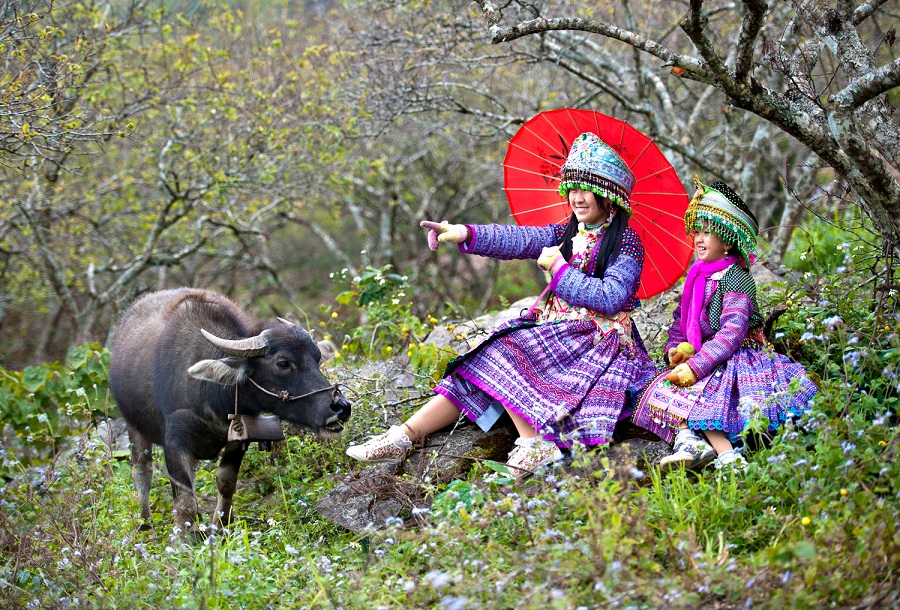
With nearly 500,000 inhabitants, H'Mong (Meo) ethnic group occupies 0.8% of the Vietnamese population. Coming from South-China some hundreds of years ago, they belong to Meo-Dao linguistic group and live mainly in Lao Cai, HaGiang, Tuyen Quang. H'Mong ethnic group grows maize, opium, subtropical fruits and vegetables, breeds cattle and hunts wild animals.
"TET MEO" - NEW YEAR FESTIVAL OF THE H'MONG PEOPLE
This is the name other fraternal peoples give to the New Year festival of the H'Mong - an ethnic minority residing on the high-mountain regions of Vietnam, ranging from the Sino-Vietnamese border in the North to NgheAn province in the centre of Vietnam. The H'Mong have developed their own calendar to calculate times of year for farming on their burnt-over land and wet-rice terraced fields. They also have their own way of identifying the date of the New Year. Perhaps no one has studied the coincidence in the timing of "Tet Meo" - the New Year festival of the H'Mong - and the Christian New Year week lasting from Christmas (December 25) through to the first day of January. At this time, peach blossoms bloom resplendently all over the H'Mong hamlets, amidst the soft and white mists. To prepare for Tet, the H'Mong put their house in order, redecorate the altar with pieces of paper cut out with stylized images of the Sun - a manifestation of the Sun-worshipping practice of the H'Mong people. These stylized drawings of the Sun are also stuck to the doors to welcome the New Year and prosperity for the family. Smaller versions (approximately 5cm x 10cm) of Sun drawings are stuck on working tools such as the hoe, plough, rake, etc. as well as on pigsties, buffalo stables, horse enclosures...... and reflect the earnest desire of the people to welcome prosperity to every element of their life. During this time, women are occupied with dressmaking and embroidery so that each family member has a smart set of clothes to wear to welcome the New Year, the most special of which is the typical dress of the H'Mong women.
On New Year's Eve, every family kills a black-and-red-feathered cock to offer in worship to the deities and ancestors. When killing the cock, they pick out bundles of red feathers and stick them with the cock's blood to the middle of the decorations of stylized Sun pictures. The cock-killing and sticking of cock feathers to the Sun drawings is considered a crucial part of the New Year-Welcome rituals of the H'Mong. This act is seen as an inseparable part of the rite of welcoming the New Year and a sign for the festivities to begin. Throughout the 7 to 8 days of Tet, the H'Mong families in each subhamlet (consisting of several houses nestling on one or two mountain slopes) take turns to kill their pigs to host group feasts. The host family commences the party by a ritual service inviting deities and their ancestors to return to join the family in celebrating the New Year in the presence of other groups of families. Only after that can the party begin in a festive atmosphere filled with laughter and the voices of all generations - elders and young, women and men, adults and children... Many feasters stay up overnight around the family fire to teach and learn songs together comprising the H'Mong service hymns, love and courting songs, kinship songs, proverbs, etc. Particularly on the first day of the New Year, the H'Mong belonging to the same group or village automatically gather in a large yard or a flat ground to take part in or to cheer traditional games amidst melodious tunes of the khen (pan-pipe), lip organ, leaf organ....The most popular game that draws a lot of participants and fans is papao shuttle. Papao is a small ball made of cloth, which is thrown between two teams - women and men. Once the ball is cast into the air, it is caught by someone in the other team. At first, the casting and catching acts seem to be natural showing no particular skills. The flying course of the papao becomes an invisible line linking and binding every couple of playmates closer "in tune" with each other. The papao shuttle lasts for hours. Participants become more and more engrossed, and they play untiringly even though the game is just a repetition of two acts - throwing and catching the ball. Naturally, the players who remain to the last minute are always couples of playmates who have fallen in love with each other and exchanged their feelings through the papao. The first happy day of a New Year not only brings a common joy to all people, but also marks the beginning of many love stories of young boys and girls. Many H'Mong couples start their love and nuptial life from the New Year welcoming day. In addition to the papao game, there are other collective events such as Con throw - a game where Con (a fringed cloth ball ) is thrown through a hoop hung at the top of a high post, and the" khen "dance is performed by talented young men who blow kh̀n and at the same time dance gracefully and alternately between lines and strong movements. Besides attending communal parties and jolly events in their own hamlet, many H'Mong take their time to visit friends in distant villages while most young people continue their dating and intimate exchanges through singing and blowing lip- and leaf-organs. During "Tet Meo", weddings of the couples whose love had been born from the papao event of the previous year are celebrated, even as new love blossoms and bears fruit by the end of the New Year or at the next New Year festival. "Tet Meo" thus ends with happiness and heralds fresh hopes for the future. (VNS)